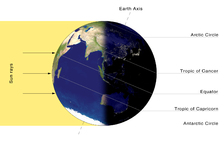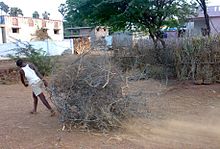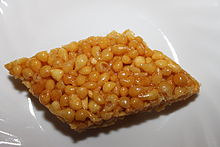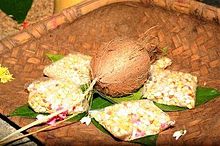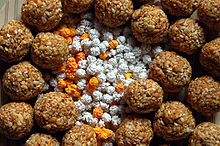- Makar Sankranti
-
Makar Sankranti (Sanskrit: मकर संक्रान्ति, Assamese: মকৰ সংক্রান্তি, Malayalam: മകര സാന്ക്രാന്തി, Oriya: ମକର ସଂକ୍ରାନ୍ତି, Tamil: தைப்பொங்கல், Telugu: మకర సంక్రాంతి, Marathi: मकर संक्रान्ति, Kannada: ಮಕರ ಸಂಕ್ರಾಂತಿ) or Sankranti or Sankranthi marks the transition of the Sun into Makara rashi (Capricorn) on its celestial path. Traditionally, this has been one of many harvest days in India.
Owing to the vast geography and diversity of culture in India, this festival is celebrated for innumerable reasons and in innumerable ways depending on the climate, agricultural environment, cultural background and location.
Contents
Date and significance
Sankranti is the Sanskrit word in Indian Astrology which refers to the transmigration of the Sun from one Rāshi (sign of the zodiac) to another. Hence there are 12 such sankrantis in all. However, the Sankranti festival usually refers to Makara Sankaranti, or the transition of the Sun from Dhanu rashi (Sagittarius) to Makara rashi (Capricorn).
For this purpose, the signs and houses of the zodiac are calculated using sidereal time, not tropical. As such it does not account for the Earth's precession. The festival therefore takes place around 21 days after the winter solstice (between December 20 and 23) that marks the starting of the phenomenon of 'northward apparent migration of the sun' or Uttarayana, literally meaning northward journey of Sun.
Considering the winter solstice marks the beginning of the gradual increase of the duration of the day. Scientifically, the shortest day of the year is around December 21–22 after which the days begin to get longer, hence actual Winter Solstice begins on December 21 or December 22 when the tropical sun enters Makara rashi. Hence actual Uttarayana is December 21. This was the actual date of Makar Sakranti too. But because of the Earth's tilt of 23.45 degrees and sliding of equinoxes, Ayanamasha occurs. This has caused Makara Sankranti to slide further over the ages. A thousand years ago, Makar Sankranti was on December 31 and is now on January 14. Five thousand years later, it shall be by the end of February, while in 9,000 years it shall come in June.[citation needed]
While the traditional Indian Calendar is based on lunar positions, Sankranti is a solar event. So while dates of all Hindu festivals keep changing as per the Gregorian calendar, the date of Makar Sankranti remains constant over a long term, 14 January. Makar Sankranti is celebrated in the Hindu Calendar month of Magha.
Makar Sankranti is a major harvest festival celebrated in various parts of India. According to the lunar calendar, when the sun moves from the Tropic of Cancer to the Tropic of Capricorn or from Dakshinayana to Uttarayana, in the month of Poush in mid-January, it commemorates the beginning of the harvest season and cessation of the northeast monsoon in South India. The movement of the earth from one zodiac sign into another is called Sankranti and as the Sun moves into the Capricorn zodiac known as Makar in Hindi, this occasion is named as Makar Sankranti in the Indian context. It is one of the few Hindu Indian festivals which are celebrated on a fixed date i.e. 14 January every year.
Makar Sankranti, apart from a harvest festival is also regarded as the beginning of an auspicious phase in Indian culture. It is said as the 'holy phase of transition'. It marks the end of an inauspicious phase which according to the Hindu calendar begins around mid-December. It is believed that any auspicious and sacred ritual can be sanctified in any Hindu family, this day onwards. Scientifically, this day marks the beginning of warmer and longer days compared to the nights. In other words, Sankranti marks the termination of winter season and beginning of a new harvest or spring season.
All over the country, Makar Sankranti is observed with great fanfare. However, it is celebrated with distinct names and rituals in different parts of the country. In the states of northern and western India, the festival is celebrated as the Sankranti day with special zeal and fervor. The importance of this day has been signified in the ancient epics like Mahabharata also. So, apart from socio-geographical importance, this day also holds a historical and religious significance. As it is the festival of Sun God and he is regarded as the symbol divinity and wisdom, the festival also holds an eternal meaning to it.
In 2011, Makar Sankranti will be celebrated on 14 January 2011.
Name
Sankranti is celebrated all over South Asia with some regional variations. It is known by different names and celebrated with different customs in different parts of the country.
In India it is known by different regional names
- Makar Sankranti or Sankranti - Andhra Pradesh, Bihar, Goa, Sikkim, Jharkhand, Karnataka, Kerala, Madhya Pradesh, Maharashtra, Manipur, Orissa, Uttar Pradesh, Uttaranchal and West Bengal.
- Uttarayan- Gujarat and Rajasthan
- Maghi - Haryana, Himachal Pradesh and Punjab
- Pongal - Tamil Nadu
- Magh Bihu or Bhogali Bihu - Assam Valley
- Shishur Saenkraat - Kashmir Valley
- Makara Vilakku Festival - Sabarimala Temple (Kerala)
In other countries too the day is celebrated but under different names and in different ways
- In Nepal,
- Tharu people - Maghi
- Other people - Maghe Sankranti or Maghe Sakrati
- In Thailand - สงกรานต์ Songkran
- In Laos - Pi Ma Lao
- In Myanmar - Thingyan
- In Cambodia - Moha Sangkran
Scriptural and cultural significance
Practices- According to the Puranas, on this day Surya(Sun) visits the house of his son Shani(Saturn), who is the lord of the Makar rashi(Zodiac Capricorn). Though the father and son duo did not get along well, the Surya made it a point to meet his son on this day. He, in fact, comes to his son’s house, for a month. This day thus symbolizes the importance of the special relationship between father and son.[1]
- From Makar Sankranti starts the ‘day’ of devatas(Gods), while dakshinayana (southward movement of the sun) is said to be the ‘night’ of devatas, so most of the auspicious things are done during this time. Uttarayana is also called as Devayana, and the dakshinayana' is called Pitrayana.[citation needed]
- It was on this day when Lord Vishnu ended the ever increasing terror of the Asuras(Demons) by finishing them off and burying their heads under the Mandara Parvata. So this occasion also represents the end of 'negativities' and beginning of an era of righteous living.[citation needed]
- Maharaja Bhagiratha, performed great penance to bring Ganga down to the earth for the redemption of 60,000 sons of Maharaj Sagar, who were burnt to ashes at the Kapil Muni Ashram, near the present day Ganga Sagar. It was on this day that Bhagirath finally did tarpan[clarification needed] with the Ganges water for his unfortunate ancestors and thereby liberated them from the curse. After visiting the Pataala(underworld) for the redemption of the curse of Bhagirath’s ancestors the Ganges finally merged into the sea. A very big Ganga Sagar Mela is organized every year on this day at the confluence of River Ganges and the Bay of Bengal. Thousands of Hindus take a dip in the water and perform tarpan for their ancestors.[2]
- Another well-known reference of this day came when the great grand-sire of Mahabharata fame, Bhishma, declared his intent to leave his mortal coil on this day. He had the boon of Ichha-Mrityu(death at his will) from his father, so he kept lying on the bed of arrows till this day and then left his mortal coil on Makar Sankranti day. It is believed that the person, who dies during the period of Uttarayana, becomes free from transmigration(rebirth). So this day was seen as a definite auspicious day to start a journey or endeavours to the higher realms beyond.[citation needed]
- Sikhs celebrate it as Maghi. The tenth Sikh Guru Gobind Singh tore the Beydaava written by 40 Sikhs and gave them Mukhti on this day. These 40 Sikhs later came to be known as 40 Mukhtas.[citation needed]
Traditions, rituals and celebration
Makar Sankranti is one of the most auspicious days for the Hindus and is celebrated in almost all parts of India in myriad cultural forms, with great devotion. Millions of people take a dip in places like Ganga Sagar (the point where the river Ganges meets the Bay of Bengal) and Prayag and pray to the Sun God (Surya). It is celebrated with pomp in southern parts of India as Pongal, and in Punjab as Maghi.
In the western Indian state of Gujarat, the celebrations are even bigger. People offer thousands of their colorful oblations to the Sun in the form of beautiful kites. The act stands as a metaphor for reaching to their beloved God, the one who represents the best. In the rural and coastal areas, cock fights are held and is a prominent event of the festival. Makara Sankranti is also to honour, worship and to pay respect to Saraswati (Goddess of Knowledge). At the start of this significant event, there is also worship for the departed ancestors.
Makara Sankranti identifies a period of enlightenment, peace, prosperity and happiness followed by a period of darkness, ignorance and viciousness with immense sorrow. The six months of northern movement of the sun is followed by six months of southern movement.
Since the festival is celebrated in mid winter, food prepared for this festival is such that it keeps the body warm and gives high energy. Laddu of til made with Jaggery is a specialty of the festival. In the western Indian state of Maharashtra it is called 'Tilgul'. In Karnataka it is called 'Yellu-Bella'. In some states cattle are decorated with various colours and are made to jump over a bon-fire.
It is celebrated differently in different regions of India.
Andhra Pradesh
The festival, Sankranti (మకర సంక్రాంతి), is celebrated for four days in Andhra Pradesh as below:
- Day 1 - Bhogi
- Day 2 - Makara Sankranti (Pedda Panduga)
- Day 3 - Kanuma
- Day 4 - Mukkanuma
The day preceding Makara Sankranti is called Bhogi(భోగి) and this is when people discard old and derelict things and concentrate on new things causing change or transformation. At dawn people light a bonfire with logs of wood, other solid-fuels and wooden furniture at home that are no longer useful. The disposal of derelict things is where all old habits, the vices, attachment to relations and materials things are sacrificed in the sacrificial fire of the knowledge of Rudra, known as the "Rudra Gita Gyan Yagya. It represents realization, transformation and purification of the soul by imbibing and inculcating divine virtues.
In many families, infants and children (usually less than three years old) are showered with fruit called "Regi Pandlu", that is the Indian jujube fruit. It is believed that doing this would protect the children from evil eye. Sweets in generous quantities are prepared and distributed. It is a time for families to congregate. Brothers pay special tribute to their married sisters by giving gifts as affirmation of their filial love. Landlords give gifts of food, clothes and money to their workforce.
The second day is Makara Sankranti , also called "Pedda Panduga" (పెద్ద పండుగ), which literally means "the big festival", when everyone wears new clothes, prays to God, and make offerings of traditional food to ancestors who have died.
On the day after Makara Sankranti, the animal kingdom is remembered and in particular, the cows. Young girls feed the animals, birds and fishes as a symbol of sharing. Travel is considered to be inappropriate, as these days are dedicated for re-union of the families. Sankranti in this sense demonstrates their strong cultural values as well as a time for change and transformation. And finally, gurus seek out their devotees to bestow blessings on them.
Kanuma Panduga (కనుమ) is not as widely celebrated, but is an integral part of the Sankranti culture. Mukkanuma (ముక్కనుమ) is popular among the non-vegetarians of the society.
People in Coastal Andhra do not eat any meat or fish during the first three days of the festival, and do so only on the day of Mukkanuma, where as people in Telangana region observe only the first two days as part of the festival and eat any meat or fish on Makara Sankranti (Pedda Panduga), the second day of the festival. For this festival all families prepare Ariselu, Appalu (a sweet made of Jaggery and Pumpkin) and make an offering to God.
This festival is celebrated in almost every village with adventurous games in South India. Whether it is the cock fights in Andhra, Bull fighting in Tamil Nadu or Elephant Mela in Kerala, there is huge amount of illegal betting but the so called "tradition" continues to play a major role in the festival.[citation needed]
Another notable feature of the festival in South India is the Haridas who goes around with a colorfully dressed cow, begging for rice wishing luck.
Assam
Main article: BihuIn Assam, the festival is celebrated as Bhogali Bihu.
Bihar
In 'Bihar' , the festival is celebrated on 14–15 January.
On 14 January, it is celebrated as Makar Sankranti or Sakraat (in local dialects).As in other parts of country, people take bath in rivers and ponds and feast upon seasonal delicacies as a celebration of good harvest.The delicacies include Chura, Gur(jaggery), various sweets made of til (Sesame seeds) such as Tilkut,Tilwa,Maska etc. ,curd , milk and seasonal vegetables.Kite flying festivals are also organized , albeit on a small scale.
On 15 January, it is celebrated as Makraat ( in some parts of the state) when people relish special Khichri(Dal-Rice replete with cauliflower,peas and potatoes).
Also, this festival is considered to be one of the most important festival. People start their day by worshiping and putting til (sesame seeds) into fire followed by eating "Dahi-chuda" along with Tilkut and Lai. File:Tilkut.jpg
Coastal regions
In the coastal regions, it is a harvest festival dedicated to Lord Indra.
Goa
Celebrations in Goa closely resemble to that in Maharashtra. The men hardly take part in the celebrations but it is the women folk who celebrate 'haldi-kumkum'
Gujarat
This is one of the major festivals in the state of Gujarat. It is a two day festival here. It is also known as Utran festival.
- 14 January is Uttarayan
- 15 January is Vasi-Uttarayan(stale Uttarayan)
Gujaratis keenly await this festival to fly kites. In India the generic name for a kite is 'Patang'. These kites are made of special light-wight kite paper and bamboo and are mostly rhombus shaped with central spine and a single bow.
In Gujarat, before the actual day of Makar sankranti, about the end of December, kids and young people start enjoying Uttarayan. Undhiyu (mixed winter vegetable) and chikkis (made from til (sesame), peanuts and jaggery) are the special festival recipes savoured on this day.
Karnataka
This is the Suggi or harvest festival for farmers of Kaveri basin of Karnataka. On this auspicious day, young females (kids & teenagers) wear new clothes to visit near and dear ones with a Sankranti offering in a plate, and exchange the same with other families. This ritual is called "Ellu Birodhu."[3] Here the plate would normally contain "Ellu" (white sesame seeds) mixed with fried groundnuts, neatly cut dry coconut & fine cut bella (Jaggery). The mixture is called "Ellu-Bella" (ಎಳ್ಳು ಬೆಲ್ಲ). The plate will also contain sugar candy molds of various shapes (Sakkare Acchu, ಸಕ್ಕರೆ ಅಚ್ಚು) with a piece of sugarcane.[4] There is a saying in Kannada "ellu bella thindu olle maathadi" which translates to 'eat the mixture of sesame seeds and jaggery and speak only good.' This festival signifies the harvest of the season, since sugarcane is predominant in these parts.[5]
In some parts of Karnataka, a newly married woman is required to give away bananas for a period of five years to married women (muthaidhe) from the first year of her marriage, but increase the number of bananas in multiples of five. There is also a tradition of some households giving away red berries "Yalchi Kai" along with the above. In North Karnataka, kite flying with community members is also a tradition. Drawing rangole in groups is another popular event among women during Sankranti.[6]
An important ritual is display of cows and cattle in colourful costumes in an open field. Cows are decorated for the occasion and taken on a procession. They are also made to cross a pyre. This ritual is common in rural Karnataka and is called "Kichchu Haisodhu."[7]
Kerala
Makara Sankranti is celebrated in Kerala at Sabarimala where the Makara Jyothi is visible followed by the Makara Vilakku celebrations. The 40 days anushthana by the devotees of Ayyappan ends on this day in Sabarimala with a big festival, called Onam.
Maharashtra
In Maharashtra on the Makar Sankranti (मकर संक्रान्ति) day people exchange multi-colored halwa (sugar granules coated in sugar syrup) and til-gul ladoos (sweetmeats made from sesame seeds and jaggery). Gul-polis (flat bread stuffed with jaggery) are offered for lunch. While exchanging tilguls as tokens of goodwill people greet each other with the words, "Til-gul ghya, god god bola" meaning ‘Accept these tilguls and speak sweet words’. The under-lying thought in the exchange of tilguls is to forget the past ill-feelings and hostilities and resolve to speak sweetly and remain friends.
This is a special day for the women in Maharashtra when married women are invited for a get-together called ‘Haldi-Kunku’ (literally meaning turmeric and vermillion) and given gifts such as utensil, clothes etc. Typically, women wear black sarees or black coloured outfits on this occasion. The significance of wearing black is that Sankranti comes at the peak of the winter season and black colour retains and absorbs heat, helping keep warm.[citation needed]
Rajasthan
This is one of the major festivals in the state of Rajasthan. It is known as "Makar Sakrat" in the Rajasthani language. This day is celebrated with sweets like Ghevar, Til-paati, Gajak, kheer etc.. Although traditionally flying kites is observed as a part of this festival.On this occasion the sky in Bikaner and Jaipur is filled with kites. People invite friends and relatives to their home for special festival meals (called as "Sakrat Bhoj").
Uttar Pradesh
In Hindu Mythology this is the first of the big bathing days. Over two million people gather at their respective sacred places for this holy bathing such as Allahabad, Haridwar and Varanasi in Uttar Pradesh.
 Kite flying in the rooftops of Varanasi
Kite flying in the rooftops of Varanasi
Kite flying is an inevitable part of the festival in Uttar Pradesh, as with many states of India such as Gujarat and Maharashtra. Like other places in India, the references to Til (Sesame seeds) and Gud (Jaggery) are also found in the songs sung on this day
Meethe GUD me mil gaya TIL,
Udi PATANG aur khil gaye DIL,
Jeevan me bani rahe SUKH aur SHANTI,
MUBARAK ho apko MAKAR-SANKRANTI.Kumaon (Uttarakhand)
In the Kumaon region of Uttarakhand Makar Sankranti is celebrated with great gusto. According to the Hindu religious texts, on the day of Uttarayani also called Ghughuti(घुघुति) in Kumaon, the sun enters the Zodiacal sign of 'Makar' (Capricon) from the Zodiacal sign of the Kark (Cancer), i.e. from this day onwards the sun becomes 'Uttarayan' or it starts moving to the north. It is said that from this day, which signals a change of season, the migratory birds start returning to the hills. On Makar Sankranti people give Khichadi (a mixture of pulses and rice) in charity, take ceremonial dips in holy rivers, participate in the Uttarayani fairs and celebrate the festival of Ghughutia or Kale Kauva. During the festival of Kale Kauva (literal translation 'black crow') people make sweetmeats out of sweetened flour (flour and gur) deep fried in ghee, shape them in shapes such as drums, pomegranates, knives, and swords. They are strung together and worn as necklace, in the middle of which an orange is fixed. Early in the morning children wear these necklaces and sing "Kale Kauva" to attract crows and other birds and offer them portions of these necklaces, as a token of welcome for all the migratory birds, who are now coming back after their winter sojourn in the plains. Wearing garlands of the above eatables the children come out calling the crows with following song on their lips: Kale Kale,
bhol bate aile bor puwa
Khale Ie Kauva bara,
mai ke de sunu gharo
Ie Kauva dhal,
mai ke de sunu thai.काले कौवा काले घुघुति माला खाले
ले कौवा बड़ा मकें दे सुणो घड़ा
ले कौवा ढाल मकें दे सुणो थाल(come dear crow, come daily you will enjoy eating bara and puwa. Take the bara and give me a pitcher full of gold. Take the shield and give me a golden plate.)
Punjab
In Punjab where December and January are the coldest months of the year, huge bonfires are lit on the eve of Makar Sankranti and is celebrated as Lohri. Sweets, sugarcane and rice are thrown in the bonfires, around which friends and relatives gather together. The following day, which is Sankrant, is celebrated as Maghi. Bathing in any river in the early hours on Maghi is important. Hindus light lamps with sesame oil as this is supposed to give prosperity and drive away all sins. The Punjabis dance their famous dance known as "Bhangra". Then they sit down and eat the sumptuous food that is specially prepared for the occasion. It is traditional to eat "kheer", rice cooked in milk and sugar.[citation needed]
Tamil Nadu
Main article: Thai PongalIt is a four day festival in Tamil Nadu:
- Day 1 - Bhogi Pandigai (Bhogi)
- Day 2 - Thai Pongal
- Day 3 - Maattu Pongal
- Day 4 - Kaanum Pongal
The festival is celebrated four days from the last day of the Tamil month Maargazhi to the third day of the Tamil month Thai.
The first day of festival is Bhogi. It is celebrated by throwing away and destroying old clothes and materials, by setting them on fire, marking the end of the old and the emergence of the new.
The second day of festival is Thai Pongal or simply Pongal. It is the main day of the festival, falling on the first day of the Tamil month Thai. It is celebrated by boiling rice with fresh milk and jaggery in new pots, which are later topped with brown sugar, cashew nuts and raisins early in the morning and allowing it to boil over the vessel. This tradition gives Pongal its name. The moment the rice boils over and bubbles out of the vessel, the tradition is to shout of "Ponggalo Ponggal!" and blowing the sangu (a conch), a custom practiced during the festival to announce it was going to be a year blessed with good tidings. Then New boiled rice is offered to the Nature during sunrise, a gesture which symbolises thanks to the sun and nature for providing prosperity. It is later served to the people present in the house for the ceremony. People also prepare savories and sweets such as vadai, murukku, payasam and visit each other and exchange greetings.
The third day of festival is Maattu Pongal. It is for offering thanks to cattle, as they help farmer in different ways for agriculture. On this day the cattle are decorated with paint, flowers and bells. They are allowed to roam free and fed sweet rice and sugar cane. Some people decorate the horns with gold or other metallic covers. In some places, Jallikattu, or taming the wild bull contest, is the main event of this day and this is mostly seen in the villages.
The fourth day of the festival is Kaanum Pongal (the word kaanum means "to view"). During this day people visit their relatives, friends to enjoy the festive season. This day is a day to thank relatives and friends for their support in the harvest. It started as a farmers festival, called as Uzhavar Thirunaal in Tamil. Kolam decorations are made in front of the house during Thai Pongal festival.
Orissa
In Orissa people prepare 'makar chaula(uncooked newly harvested rice, banana, coconut, jaggery, sesame, rasagola, khoi and chhena puddings for naivedya to gods and goddesses.The withdrawing winter entails change in food habits & intake of nourishing and rich food. Therefore this festival also holds immense scientific significance. According to the Sun's movement, the days from this day onwards become lengthy and warmer and so the Sun-God is worshipped as a great benefactor. Makar Mela is observed at Dhabaleswar in Cuttack, Hatakeshwar at Atri in Puri, Makar Muni temple in Balasore and near various deities in each district of Orissa. In the temple of Lord Jagannath this festival is observed as 'Uttarayana Yatra'. In Mayurbhanj, Keonjhar,kalahandi, koraput and Sundargarh where the tribal population is more, the festival is celebrated with great joy. They have been celebrating this festival with great enthusiasm. They sing, dance and enjoy. Many tribals in our country start their New Year from the day of Sankranti by lighting bonfires, dancing and eating their particular dishes sitting together. The Bhuya tribals of Orissa have their Maghyatra in which small home-made articles are put for sale.
West Bengal
In West Bengal, Sankranti, also known as Poush Sankranti named after the Bengali month in which it falls, is celebrated as a harvest festival Poush Parbon (Bengali: পৌষ পার্বণ). (It always falls on the 14th January on the English calendar). The freshly harvested paddy along with the date palm syrup in the form of Khejurer Gur (Bengali: খেজুরের গুড়)and Patali (Bengali: পাটালি ) is used in the preparation of a variety of traditional Bengali sweets made with rice flour, coconut, milk and 'khejurer gur' (palm jaggery) and known as Pithey (Bengali: পিঠে). All sections of society participate in a three-day begins on the day before Sankranti and ends on the day after. The Goddess Lakshmi is usually worshipped on the day of Sankranti. In the Himalayan regions of Darjeeling, the festival is known as Magey Sakrati. It is distinctly associated with the worship of Lord Shiva. Traditionally, people were required to take a bath before sunrise and then commence their pooja. The food that is consumed consists primarily of sweet potatoes and various yams.
Melas
Many Melas or fairs are held on Makar Sankranti the most famous being the Kumbh Mela, held every 12 years at one of four holy locations, namely Haridwar, Prayag (Allahabad), Ujjain and Nashik. The Magh Mela (or mini-Kumbh Mela held annually at Prayag) and the Gangasagar Mela (held at the head of the Ganges River, where it flows into the Bay of Bengal). Makar Mela in Orissa. Tusu Mela also called as Tusu Porab is celebrated in many parts of Jharkhand and West Bengal.
See also
- Sinhala and Tamil new year in Sri Lanka
- Hindu festivals
- Pohela Boishakh Bangladesh
- Songkran Thai New Year
- Uttarayana
- Water Festival
References
- ^ [1] Images of Ganga Sagar Mela-Source-Google Images
- ^ [2] Seven killed in stampede at Gangasagar mela-Source-Times of India
- ^ Makar Sankranti in Karnataka
- ^ The Hindu - Yellu mixture, sugar candy (sakkare acchu), sugarcane
- ^ Sankraanti Among Kannidigas
- ^ Sankranti celebrated in a special way
- ^ Festivals in Karnataka » Makara Shankranti
External links
- When is Makar Sankranti? Dates of Makar Sankranti until 2010
- Makar Sankranti and the Hindu Samaj
- How Makara Sankranthi is celebrated in India
- Makar samkranti dates in different parts of the world
Festivals in the Hindu calendar Major festivals - Pongal (Makar Sankranti)
- Holi
- Rama Navami
- Krishna Janmashtami
- Maha Shivaratri
- Onam
- Ganesh Chaturthi
- Navratri (Mysore Dasara – Durga Puja – Vijayadashami)
- Diwali (Bhau-Beej)
- Chhath
- Vat Purnima

Regional New Year - Gudi Padwa (Marathi, Konkani)
- Ugadi (Telugu, Kannada)
- Cheti Chand (Sindhi)
- Bihu (Assamese)
- Vaisakhi (Punjabi)
- Vishuva Sankranti (Oriya)
- Pohela Boishakh (Bengali)
- Puthandu (Tamil)
- Vishu (Malayalee)
Holy days Holy periods Winter solstice and midwinter festivals Africa 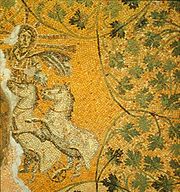
Americas Inti Raymi°: Peru, Bolivia, Ecuador (Inca†) • Jonkonnu°: Caribbean° (African American) • Soyal: US (Zuni, Hopi) • Wayeb': Guatemala° (Maya) • We Tripantu: Chile (Mapuche)Asia Amaterasu†: Japan • Choimus • Deygān, Maidyarem°: (Zoroastrian) • Dōngzhì, Tōji: (East Asian) • Lohri, Pongal, Makar Sankranti°: India(Hindu) • Sanghamitta Day: Sri Lanka (Buddhist) • Şeva Zistanê: (Kurdish) • Yalda: Iran (Persian)Europe Beiwe: (Saami) • Brumalia†: Ancient Greece • Christmas: Roman Empire° (Christian) • Dies Natalis Solis Invicti†: Roman Empire • Deuorius Riuri†: Gaul • Hogmanay°: Scotland • Karachun°: (West Slavs) • Mōdraniht†: Western Germany (Matres and Matrones) • Midvinterblót†: Sweden (Norse) • Montol Festival, Mummer's Day°: Cornwall (Celts) • Saturnalia†: Rome • Wren's Day°: Ireland, Isle of Man, Wales (Celts) • Yule, Jul°: (Germanic) • Ziemassvētki: Baltic (Romuva)† dagger indicates extinction. ° degree symbol indicates changes in date, name or location. ( ) indicate demographic Bengali Hindus Castes 
Sects Religious Bodies Festivals Poila Baisakh · Rathayatra · Janmashtami · Bhadu · Vishwakarma Puja · Durga Puja · Lakshmi Puja · Kali Puja · Bhai Phonta · Nabanna · Jagaddhatri Puja · Makar Sankranti · Saraswati Puja · GajanFolk Arts Dhokra · SholapithFolk Dances Folk Songs Alkap · KaviganCategories:- Festivals in India
- Hindu festivals
- January observances
- Gujarati culture
- Festivals in Nepal
- Hindu astronomy
- Winter festivals
- Winter holidays
Wikimedia Foundation. 2010.


